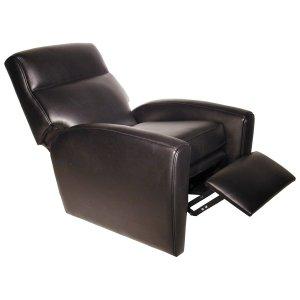Recliner
Recliner
A recliner is a type of armchair or sofa that reclines when the occupant lowers the chair's back and raises its front. It has a backrest that can be tilted back, and often a footrest that may extend automatically when the back is reclined or can be extended manually. Recliners are popular in the furniture industry for providing exceptional comfort and are often associated with relaxation and leisure.
History[edit | edit source]
The history of the recliner dates back to the late 19th century. Although the exact origins are debated, recliners became popular in the early 20th century, evolving from simple reclining chairs to more sophisticated designs with mechanical systems for reclining the chair.
Design and Mechanism[edit | edit source]
Modern recliners come in various designs, including manual recliners, which use levers or pulls to recline the chair, and electric or power recliners, which use motors to control the reclining mechanism. Some recliners also feature adjustable headrests, lumbar support, and even massage functions to enhance comfort.
The mechanism that allows a recliner to move can vary from a simple push-back design, where the user leans back to recline the chair, to more complex systems with levers, gears, and motors. The construction of a recliner is more complex than that of a standard chair, requiring durable materials and engineering to accommodate the moving parts and the weight of the user.
Types of Recliners[edit | edit source]
There are several types of recliners, catering to different preferences and needs:
- Rocker Recliners: These chairs rock back and forth while reclined.
- Glider Recliners: Similar to rockers but move forward and backward on a linear path.
- Swivel Recliner Chairs: These chairs can swivel around a base axis.
- Lift Chairs: Designed for individuals with limited mobility, these recliners tilt forward to help the user get into a standing position.
- Wall-Hugger Recliners: Ideal for small spaces, these recliners can be placed closer to a wall and still recline without hitting the wall.
Materials[edit | edit source]
Recliners are made from a variety of materials, including leather, fabric, and microfiber, each offering different levels of comfort, durability, and maintenance requirements. The choice of material can affect the appearance, feel, and longevity of the recliner.
Health Benefits and Considerations[edit | edit source]
Recliners can offer several health benefits, including improved circulation, relief from back pain, and reduced pressure on the spine, by allowing the user to adjust their seating position. However, it's important for users to choose a recliner that provides proper support and to be mindful of spending too much time in a reclined position, which can lead to other health issues.
Maintenance[edit | edit source]
Maintaining a recliner involves regular cleaning, depending on the material, and periodic checks of the mechanical parts to ensure they are functioning correctly. Proper maintenance can extend the life of a recliner and keep it looking and working its best.
Conclusion[edit | edit source]
Recliners have become a staple in homes around the world, offering a blend of comfort, style, and functionality. Whether for watching TV, reading, or simply relaxing, a recliner can provide a comfortable retreat in any living space.
Search WikiMD
Ad.Tired of being Overweight? Try W8MD's physician weight loss program.
Semaglutide (Ozempic / Wegovy and Tirzepatide (Mounjaro / Zepbound) available.
Advertise on WikiMD
|
WikiMD's Wellness Encyclopedia |
| Let Food Be Thy Medicine Medicine Thy Food - Hippocrates |
Translate this page: - East Asian
中文,
日本,
한국어,
South Asian
हिन्दी,
தமிழ்,
తెలుగు,
Urdu,
ಕನ್ನಡ,
Southeast Asian
Indonesian,
Vietnamese,
Thai,
မြန်မာဘာသာ,
বাংলা
European
español,
Deutsch,
français,
Greek,
português do Brasil,
polski,
română,
русский,
Nederlands,
norsk,
svenska,
suomi,
Italian
Middle Eastern & African
عربى,
Turkish,
Persian,
Hebrew,
Afrikaans,
isiZulu,
Kiswahili,
Other
Bulgarian,
Hungarian,
Czech,
Swedish,
മലയാളം,
मराठी,
ਪੰਜਾਬੀ,
ગુજરાતી,
Portuguese,
Ukrainian
Medical Disclaimer: WikiMD is not a substitute for professional medical advice. The information on WikiMD is provided as an information resource only, may be incorrect, outdated or misleading, and is not to be used or relied on for any diagnostic or treatment purposes. Please consult your health care provider before making any healthcare decisions or for guidance about a specific medical condition. WikiMD expressly disclaims responsibility, and shall have no liability, for any damages, loss, injury, or liability whatsoever suffered as a result of your reliance on the information contained in this site. By visiting this site you agree to the foregoing terms and conditions, which may from time to time be changed or supplemented by WikiMD. If you do not agree to the foregoing terms and conditions, you should not enter or use this site. See full disclaimer.
Credits:Most images are courtesy of Wikimedia commons, and templates, categories Wikipedia, licensed under CC BY SA or similar.
Contributors: Prab R. Tumpati, MD


